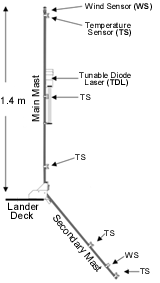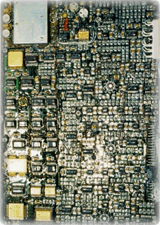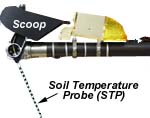|
The Mars Volatiles and Climate Surveyor's Meterological Package (MET) will function as a Martian weather station. The package consists of a collection of sensors at various heights on two masts, as well as a four pressure sensors that reside on the lander deck. The temperature and wind sensors along the main and secondary masts (right) will provide accurate profiles of temperature, wind, and water vapor between 15 cm above the surface and 1.4 meters above deck. The Tunable Diode Laser (TDL) Spectrometer on the main mast will also provide the first direct measurements of water vapor near the Martian surface. MET will provide the first surface-based observations of weather in the southern hemisphere of Mars, as well as the first in either polar region. In addition to providing information about atmospheric processes over a wide range of scales, the package will acquire environmental information that will aid in general lander operations and in the interpretation of data from other MVACS instruments.
MET was designed and built at the Jet Propulsion Laboratory (JPL) under the direction of David Crisp. Ari-Matti Harri (Finnish Meteorological Institute), Randy May (Spectrasensors, Inc.), and Richard Zurek (JPL) are also Co-Investigators.
|

|
Parts of the MET and Their Function:
- The MET Mast
The 3 temperature sensors on the 1.4-meter main mast will measure the air temperature at different levels above the deck. The wind sensor at the top of the mast will measure both wind speed and direction.
- The Tunable Diode Laser (TDL)
The TDL spectrometer on the MET mast,measures the atmospheric water vapor abundance and the relative amounts of oxygen, carbon, and hydrogen isotopes in water vapor and carbon dioxide. This sensor evolved from instruments used to measure water and other trace gases in the Earth's stratosphere. It was designed by Dr. Randy May (formerly at JPL, now at Spectrasensors, Inc.).
- The Secondary MET Mast
A smaller mast deploys downward, below the deck, to measure the temperature and wind speed near the surface. These measurements will help us to understand how the thin Martian atmosphere raises enough dust to generate large dust storms.
- The Robotic Arm Atmospheric Temperature Sensor (RAATS)
This sensor, located on the "elbow" of the Robotic Arm will allow scientists to read the temperature at any level, just by moving the Robotic Arm. It will acquire temperature measurements near the lander deck that are not contaminated by waste heat from the lander, when the wind is blowing from the opposite side of the deck from where the two masts are mounted.
- The Pressure Sensor
The MET Pressure Sensor, located in the Payload Electronics Box, will measure the changes in the atmospheric pressure near the surface. Early in the mission, pressure data will be used to establish the altitude of the landing site. These measurements will also allow us to measure the passage of weather fronts, dust storms, and meteorological phenomena. The Pressure Sensor was provided to NASA by the Finnish Meteorological Institute, Department of Geophysics (FMI/GEO).
- The Soil Temperature Probe (STP)
The STP is located on the "wrist" of the Robotic Arm, and can be pushed into the ground to measure the temperature of the Martian soil. This allows scientists to record the temperature of the soil just below the surface. When in the soil, the black and white markings indicate the depth at which it is taking measurements. Its measurements will be used to study temperature variations within the upper few cm of the Martian surface. These measurements will complement the atmospheric temperature measurements taken by the sensors on MET. The STP was built by Dr. Stephen Wood (formerly at UCLA, now at the University of Washington).
|

Wind and temperature sensors located atop the MET mast

One of the MET Electronics Boards

The Soil Temperature Probe and the Robotic Arm Scoop
|



















